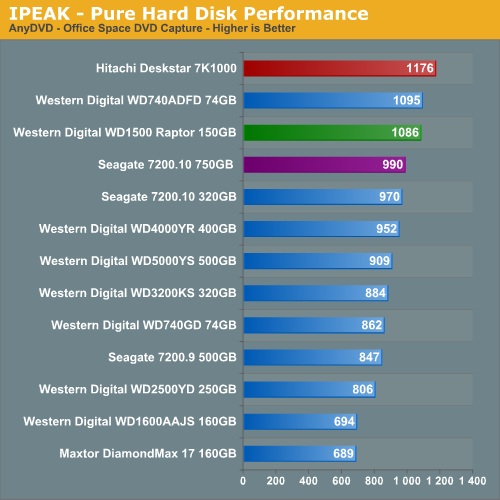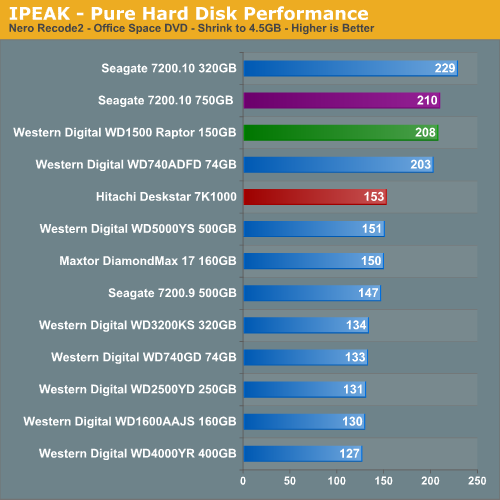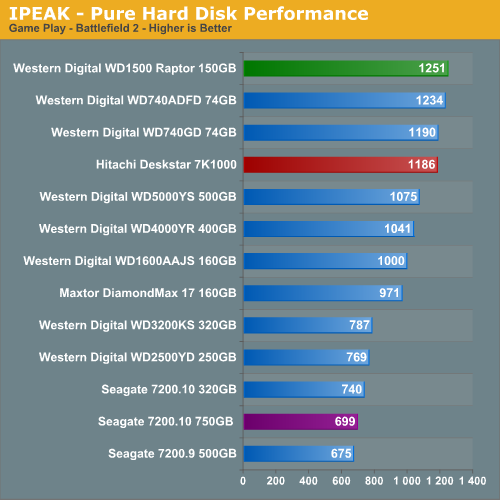Hitachi Deskstar 7K1000: Terabyte Storage arrives on the Desktop
by Gary Key on March 19, 2007 8:00 AM EST- Posted in
- Storage
iPeak Video/Audio Tests
The iPeak based Video/Audio benchmarks are designed around simulating media encoding and HTPC activities. These are basic benchmarks at this time as this section will be expanded once we start testing under Vista. Our change to a dual core processor will assist us in maintaining a balance between the CPU and Storage systems during the trace file creation and benchmarking processes. These benchmarks are CPU intensive in nature but also require a balanced storage system with the ability to handle read and write requests simultaneously in a very efficient manner.


The AnyDVD benchmark is heavily weighted to write requests with the results showing a common pattern with the two 16MB cache Raptors finishing second and third with the 7K1000 once again showing its strength in the write intensive benchmarks due to its areal density and large cache design. We found the Seagate 750GB was pausing during streamed writes due to the smaller cache size after witnessing buffer overruns in the trace file when compared to the Hitachi drive.
The NeroRecode 2 benchmark is weighted to streaming read requests but is balanced by continuous write operations near the end of the test. This benchmark is one of the most demanding ones in our test suite with the disk being active the entire trace file with several 100% utilization peaks. The results surprised us as we expected the Hitachi with its 32 MB cache and high sustained transfer rates to handle this benchmark with aplomb.
However, it turns out after reviewing the trace file results it was obvious that the 7K1000 was hampered by its inability to process large data blocks in sequential order efficiently as it had a number of buffer overruns during the read portion of the tests. This indicates to us the drive firmware is probably tuned more for non-sequential read/writes as the rest of our tests indicate. However, the 32 MB cache should have easily compensated for any potential large block issues in this test and the drive handled previous read heavy request tests with ease. Our initial test results with AAM off only show a two point advantage in this test. We are currently completing tests with AAM/NCQ off and will update the article if there are any noticeable performance differences.
iPeak Game Installation Tests
Our iPeak based Game Installation benchmarks simply show the ability of the hard drive to write data as quickly as possible to the disc based upon the installation software instructions. As detailed in our iPeak setup description we installed the games from our source drive in order to eliminate the optical drive bottleneck. In separate application timing we witnessed basically the same percentage spread when installing the games via our DVD drive so these results are representative of actual installation performance.


The Raptors once again finish at or near the top in our gaming tests due to their rotational and random access speeds. Our 7K1000 drive finishes ahead of the 7200rpm drives with a great deal of benefit going to the 32 MB cache and high sustained transfer rates. A review of the trace files did not indicate any real standout issues with the Seagate 750GB drive although we noticed several minor dips in performance when the drive was reading information off the source drive. The write performance was generally slower than the 7K1000 in this test and follow previous benchmark results.
We need to remember these tests reflect pure hard drive performance and will be mitigated by the overall system platform as we will see in our application tests. These tests are basically designed around continual read/write requests that favor large cache sizes, properly tuned firmware, and high sustained transfer rates.
iPeak Game Play Tests
The iPeak based Game Play tests are centered on the benefits of having a hard disk that can load non-linear or sequential data files quickly without interrupting the flow of the game.


When it comes to gaming the Raptors rule but the 7K1000 is not that far behind with a second place tie in the disk intensive Sims2 and a strong fourth place finish in Battlefield 2. Although we are looking at pure performance results, in subjective testing we finally have a 7200rpm drive that "feels" as fast as the Raptor family of drives when loading or playing a game. The best overall gaming performance in a drive with a SATA interface is still the Raptors but considering the storage size, acoustic, and cost per-Gigabyte advantages of the Hitachi drive we are heavily leaning towards changing our recommendation.
The iPeak based Video/Audio benchmarks are designed around simulating media encoding and HTPC activities. These are basic benchmarks at this time as this section will be expanded once we start testing under Vista. Our change to a dual core processor will assist us in maintaining a balance between the CPU and Storage systems during the trace file creation and benchmarking processes. These benchmarks are CPU intensive in nature but also require a balanced storage system with the ability to handle read and write requests simultaneously in a very efficient manner.


The AnyDVD benchmark is heavily weighted to write requests with the results showing a common pattern with the two 16MB cache Raptors finishing second and third with the 7K1000 once again showing its strength in the write intensive benchmarks due to its areal density and large cache design. We found the Seagate 750GB was pausing during streamed writes due to the smaller cache size after witnessing buffer overruns in the trace file when compared to the Hitachi drive.
The NeroRecode 2 benchmark is weighted to streaming read requests but is balanced by continuous write operations near the end of the test. This benchmark is one of the most demanding ones in our test suite with the disk being active the entire trace file with several 100% utilization peaks. The results surprised us as we expected the Hitachi with its 32 MB cache and high sustained transfer rates to handle this benchmark with aplomb.
However, it turns out after reviewing the trace file results it was obvious that the 7K1000 was hampered by its inability to process large data blocks in sequential order efficiently as it had a number of buffer overruns during the read portion of the tests. This indicates to us the drive firmware is probably tuned more for non-sequential read/writes as the rest of our tests indicate. However, the 32 MB cache should have easily compensated for any potential large block issues in this test and the drive handled previous read heavy request tests with ease. Our initial test results with AAM off only show a two point advantage in this test. We are currently completing tests with AAM/NCQ off and will update the article if there are any noticeable performance differences.
iPeak Game Installation Tests
Our iPeak based Game Installation benchmarks simply show the ability of the hard drive to write data as quickly as possible to the disc based upon the installation software instructions. As detailed in our iPeak setup description we installed the games from our source drive in order to eliminate the optical drive bottleneck. In separate application timing we witnessed basically the same percentage spread when installing the games via our DVD drive so these results are representative of actual installation performance.


The Raptors once again finish at or near the top in our gaming tests due to their rotational and random access speeds. Our 7K1000 drive finishes ahead of the 7200rpm drives with a great deal of benefit going to the 32 MB cache and high sustained transfer rates. A review of the trace files did not indicate any real standout issues with the Seagate 750GB drive although we noticed several minor dips in performance when the drive was reading information off the source drive. The write performance was generally slower than the 7K1000 in this test and follow previous benchmark results.
We need to remember these tests reflect pure hard drive performance and will be mitigated by the overall system platform as we will see in our application tests. These tests are basically designed around continual read/write requests that favor large cache sizes, properly tuned firmware, and high sustained transfer rates.
iPeak Game Play Tests
The iPeak based Game Play tests are centered on the benefits of having a hard disk that can load non-linear or sequential data files quickly without interrupting the flow of the game.


When it comes to gaming the Raptors rule but the 7K1000 is not that far behind with a second place tie in the disk intensive Sims2 and a strong fourth place finish in Battlefield 2. Although we are looking at pure performance results, in subjective testing we finally have a 7200rpm drive that "feels" as fast as the Raptor family of drives when loading or playing a game. The best overall gaming performance in a drive with a SATA interface is still the Raptors but considering the storage size, acoustic, and cost per-Gigabyte advantages of the Hitachi drive we are heavily leaning towards changing our recommendation.










74 Comments
View All Comments
phusg - Tuesday, March 20, 2007 - link
I think you are right, but don't forget that in this post you are only looking at it from a performance viewpoint. Drive longevity and acoustics are major factors to me, and I think for you too from the article. I think these are the metrics worth looking at and tend to agree that subjective performance doesn't really differentiate that much (although I haven't had half as much experience with different vendors/models as you have).gramboh - Monday, March 19, 2007 - link
I read the review earlier this morning but don't recall seeing anything about retail channel availability. Did Hitachi or Dell comment to AT about this?I'm actually interested in 500GB 7200.10's and hoping this release will push the price of those down a lot.
Gary Key - Monday, March 19, 2007 - link
We do not have an exact date. Hitachi committed to having product into the retail channel by the end of Q1. We should have an answer from Dell tomorrow on when they will offer it outside of their systems. Hitachi is saying the drive will launch at $399, just waiting to see $550 price tags when the first drives show up... ;)Jeff7181 - Monday, March 19, 2007 - link
This might find it's way into my computer later this year. :)BUL - Monday, March 19, 2007 - link
Interesting that perpendicular technology was chosen given the R&D costs (with the tiny return of ~5 years before obsolescence--the article mentions that perpendicular can ONLY go 5x denser with existing techology & figure we'll see 5TB perpendicular drives in 2 years), etc... So why don't manufacturers offer 5 1/4" drives? Not to invoke memories of the MFM drives of long-ago (the original XT had a double-size 5 1/4" MFM drive of 10MB), but they have potentially 50-60% more surface area per platter, and with a possibility of 7(?) platters, isn't that a better solution? True, you wouldn't put them in SFFs or notebooks, but how many of us have towers with empty 5 1/4" bays??? And I assume that a 1TB 5 1/4" drive would be more energy-efficient than two 500GB 3 1/2" drives...Also, has anyone REALLY tested to see if perpendicular is truly a reliable technology? Seems like manufacturers have 50 years of experience with parallel storage, and only 1-2 years using perpendicular storage...
Spoelie - Tuesday, March 20, 2007 - link
Bulkier, slower, less energy efficient and more moving parts that reduce reliability all in the name of increased capacity is not the way to the future. I think the biggest problem at the moment is NOT storage capacity, they're mostly increasing capacity to keep HDs evolving and not drop in price, as it's one of the only competitive advantages. If you can increase capacity with the same material cost and some extra R&D, it would be stupid not to do it, and a better way than increasing the material cost.In fact, regular folk have way too much capacity at the moment. A Seagate CEO worded it nicely a while back "Face it, we're not changing the world. All we do is enable people to store more crap/porn."
The future lies in the direction of flash based hard drives: smaller, less/no moving parts instead of more, faster access times, lower energy consumption/heat. Or other alternative technologies that offer the same advantages. The densities and cost are the only reasons we're not all buying them at the moment, something that should be fixed over time.
If you're worried about unused case slots, buy one of those things that enable you to install normal hard drives in it, or convince the case designers to include more 3 1/2" slots and less 5 1/4" slots.
misuspita - Monday, March 19, 2007 - link
Have you ever seen a slow motion filming of a cd-rom disk wobbling? Same thing here! I think the platters got smaller because the vibrations produced by them grew with the speed. Since today's r/w heads need to be extremely close to the surface, that would be utterly impossible to control at that speed and diameter. They changed also from an aluminum based disk to an glass based one also, because the roughness of the surface on the Al platter.tygrus - Monday, March 19, 2007 - link
It's harder to spin a large diametter platter at high speed. More weight, more wobble, slower access times. I saw once a 5.25" 4x2.5" SATA drive array. Quantum used to do a large format BigFoot for cheap, slow large capacity but it wasn't continued. We have plenty of capacity per platter but limited perf/GB (worse every year) so why decrease performance to increase capacity ?piroroadkill - Monday, March 19, 2007 - link
All of the Seagate Barracuda 7200.10 drives have been perpendicular for some time..It seems like a perfectly reliable tech to me
Olaf van der Spek - Monday, March 19, 2007 - link
How smart is it to use temperatures from SMART?Did you verify all HDDs use good quality unbiased temperature sensors?
> Our thermal tests utilize sensor readings via the S.M.A.R.T. (Self-Monitoring, Analysis and Reporting Technology) capability of the drives and are reported by utilizing the Active SMART 2.42 utility.